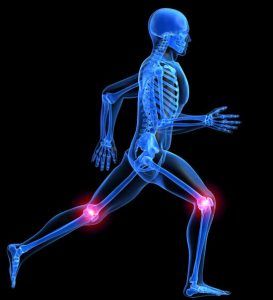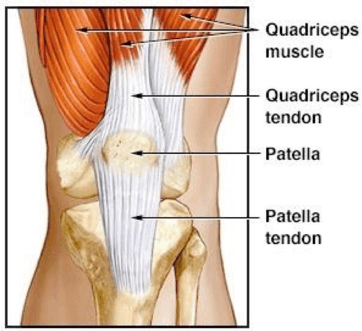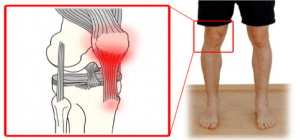
Patella Tendinopathy is a common source of Anterior Knee Pain
The Anatomy
The patella tendon is a strong elastic connection between the quadriceps muscle and tibia (shin bone) that transfers high levels of force through the musculoskeletal system during high impact loading such as running and jumping, whilst also playing an important role in extending the knee. Whilst the tendon is a strong and robust structure, if overloaded it can gradually weaken and progress into a tendinopathy.

What is Patella Tendinopathy?
Tendinopathy known as Anterior knee pain (pain over the front of the knee) can be caused by numerous structures and contributing factors, and is a frequent cause of dysfunction and non-participation in an individual’s sports and recreational activities. One of the most common causes of anterior knee pain is a condition known as Patella Tendinopathy (or Jumpers Knee). This condition is characterised by pain isolated to the patella tendon just below the kneecap and load related pain that increases with contraction of the quadriceps muscles, especially with high force activities such as jumping and running.
Patella Tendinopathy primarily affects relatively young individuals aged from 15 to 30 years of age who participate in sports such as basketball, volleyball, athletics, tennis and rugby league, all of which require high force repetitive loading of the quadriceps and patella tendon. While the prognosis of this condition is good, it can often be a time consuming rehab process, with symptoms usually lasting anywhere between three months and one year.

What Factors Influence the Onset of Patella Tendinopathy?
1. Rapid Increases in Training Volume, Frequency and Intensity
As previously mentioned, when a tendon is healthy it is able to tolerate high loads and adapt to activities such as running and repetitive jumping, however if the tendon exceeds its capacity and becomes overloaded, it may become irritated and painful. Rapid increases in training volume, frequency or intensity may all predispose the patella tendon to increased risk of developing into a painful tendinopathy. As a general rule, an athlete should increase their training load by no more than 10% per week to give their body enough time to recover and adapt, whilst also reducing injury risk.
2. Change in Ground Surface Density
Running and jumping on hard surfaces such as concrete, hardwood and bitumen subjects the patella tendon to increased forces and may be a risk factor in the development of Patella Tendinopathy. By ensuring adequate footwear to absorb shock, gradually introducing new surfaces and ensuring the athlete has efficient running and landing technique, the risk of developing a Patella Tendinopathy can be minimised.
3. Biomechanics
Running, jumping and landing technique can all be contributing factors in the onset of Patella Tendinopathy, while they are only a small part of the picture, it is essential that they are addressed to assist in preventing the onset of a Patella Tendinopathy, or as a part of an athlete’s rehabilitation following diagnosis.
4. Quadriceps and Hamstring Strength
Having strong quadriceps and hamstring muscles can greatly reduce the risk of developing a Patella Tendinopathy, with sufficient quadriceps strength thought to be protective of the tendon. So while the cause of Patella Tendinopathy is often due to overload of the tendon and quadriceps muscle, the remedy is also often strengthening exercises at the right level. This ensures the tendon gradually regains its ability to tolerate the heavy loads required for running and jumping sports.

Pictured: The leg extension and banded wall squat are both great rehab exercises for Patella Tendinopathy when programmed effectively
5. Male Gender
Bad luck gents, if you’re a male athlete that participates in high force jumping sports as mentioned earlier in the blog, you’re up to four times more likely to develop Patella Tendinopathy than your female counterparts. This may be due to higher body mass, larger muscle mass and greater jumping ability, resulting in increased stress on the patella tendon.
6. High BMI
Being overweight or obese also predisposes an individual to developing Patella Tendinopathy. This is due to the increased load through the tendon during walking, running and jumping. For these patients weight loss is an important aspect of their management, with recent evidence showing that a reduction of just 5% body weight can lead to a 20% reduction in loading at the knee joint, so every bit helps!
Management of Patella Tendinopathy
The management of Patella Tendinopathy initially involves the consideration of the aforementioned contributing factors in each patients presentation, alongside a gradual strengthening program of the quadriceps muscles with the goal of increasing the patella tendons ability to tolerate load. As symptoms improve, your Physiotherapist or Exercise Physiologist will gradually re-introduce sporting activities such as running and jumping as the patient progresses towards a pain free return to sport.
It is important to note that Patella Tendinopathy is the source of one of many knee issues that can present with pain over the front of the knee. So if you’ve been experiencing knee pain that’s affecting your daily activities, it is essential that you make an appointment with your Physiotherapist for a comprehensive assessment and management plan to ensure your recovery is on the right path.
Physiotherapist Lachlan Skinner
Book online today.


